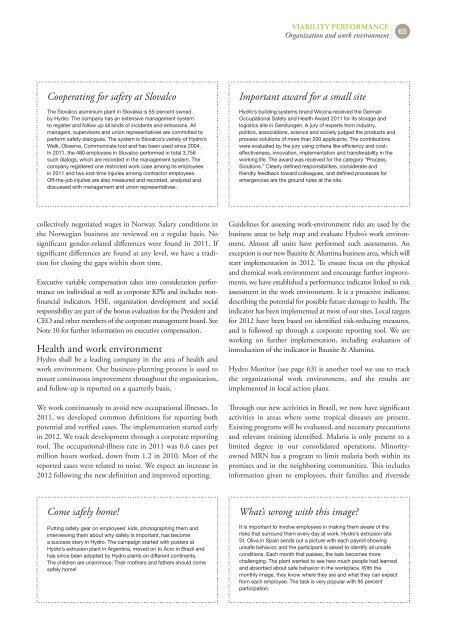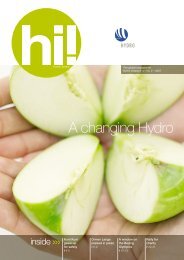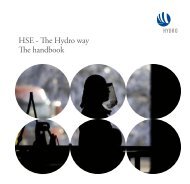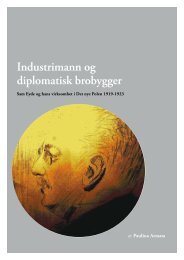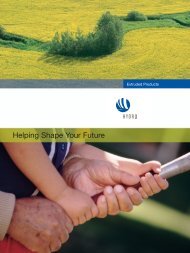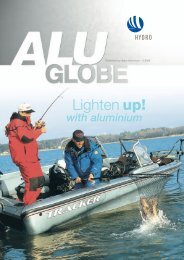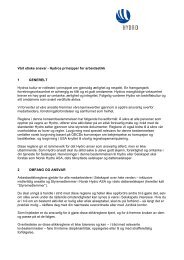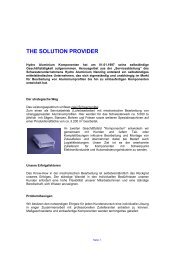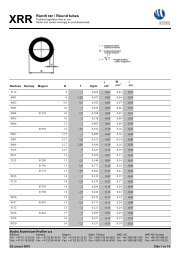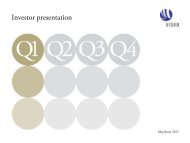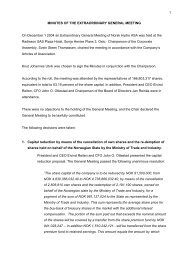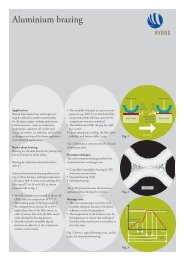Hydro Annual Report 2011b
Hydro Annual Report 2011b
Hydro Annual Report 2011b
You also want an ePaper? Increase the reach of your titles
YUMPU automatically turns print PDFs into web optimized ePapers that Google loves.
Cooperating for safety at Slovalco<br />
The Slovalco aluminium plant in Slovakia is 55-percent owned<br />
by <strong>Hydro</strong>. The company has an extensive management system<br />
to register and follow up all kinds of incidents and emissions. All<br />
managers, supervisors and union representatives are committed to<br />
perform safety dialogues. The system is Slovalco’s variety of <strong>Hydro</strong>’s<br />
Walk, Observe, Communicate tool and has been used since 2004.<br />
In 2011, the 480 employees in Slovalco performed in total 3,756<br />
such dialogs, which are recorded in the management system. The<br />
company registered one restricted work case among its employees<br />
in 2011 and two lost-time injuries among contractor employees.<br />
Off-the-job injuries are also measured and recorded, analyzed and<br />
discussed with management and union representatives.<br />
collectively negotiated wages in Norway. Salary conditions in<br />
the Norwegian business are reviewed on a regular basis. No<br />
significant gender-related differences were found in 2011. If<br />
significant differences are found at any level, we have a tradition<br />
for closing the gaps within short time.<br />
Executive variable compensation takes into consideration performance<br />
on individual as well as corporate KPIs and includes nonfinancial<br />
indicators. HSE, organization development and social<br />
responsibility are part of the bonus evaluation for the President and<br />
CEO and other members of the corporate management board. See<br />
Note 10 for further information on executive compensation.<br />
Health and work environment<br />
<strong>Hydro</strong> shall be a leading company in the area of health and<br />
work environment. Our business-planning process is used to<br />
ensure continuous improvement throughout the organization,<br />
and follow-up is reported on a quarterly basis.<br />
We work continuously to avoid new occupational illnesses. In<br />
2011, we developed common definitions for reporting both<br />
potential and verified cases. The implementation started early<br />
in 2012. We track development through a corporate reporting<br />
tool. The occupational-illness rate in 2011 was 0.6 cases per<br />
million hours worked, down from 1.2 in 2010. Most of the<br />
reported cases were related to noise. We expect an increase in<br />
2012 following the new definition and improved reporting.<br />
Come safely home!<br />
Putting safety gear on employees’ kids, photographing them and<br />
interviewing them about why safety is important, has become<br />
a success story in <strong>Hydro</strong>. The campaign started with posters at<br />
<strong>Hydro</strong>’s extrusion plant in Argentina, moved on to Acro in Brazil and<br />
has since been adopted by <strong>Hydro</strong> plants on different continents.<br />
The children are unanimous: Their mothers and fathers should come<br />
safely home!<br />
vIABIlItY perForMAnCe<br />
Organization and work environment<br />
Important award for a small site<br />
<strong>Hydro</strong>’s building systems brand Wicona received the German<br />
Occupational Safety and Health Award 2011 for its storage and<br />
logistics site in Gerstungen. A jury of experts from industry,<br />
politics, associations, science and society judged the products and<br />
process solutions of more than 200 applicants. The contributions<br />
were evaluated by the jury using criteria like efficiency and costeffectiveness,<br />
innovation, implementation and transferability in the<br />
working life. The award was received for the category “Process<br />
Solutions.” Clearly defined responsibilities, considerate and<br />
friendly feedback toward colleagues, and defined processes for<br />
emergencies are the ground rules at the site.<br />
65<br />
Guidelines for assessing work-environment risks are used by the<br />
business areas to help map and evaluate <strong>Hydro</strong>’s work environment.<br />
Almost all units have performed such assessments. An<br />
exception is our new Bauxite & Alumina business area, which will<br />
start implementation in 2012. To ensure focus on the physical<br />
and chemical work environment and encourage further improvements,<br />
we have established a performance indicator linked to risk<br />
assessment in the work environment. It is a proactive indicator,<br />
describing the potential for possible future damage to health. The<br />
indicator has been implemented at most of our sites. Local targets<br />
for 2012 have been based on identified risk-reducing measures,<br />
and is followed up through a corporate reporting tool. We are<br />
working on further implementation, including evaluation of<br />
introduction of the indicator in Bauxite & Alumina.<br />
<strong>Hydro</strong> Monitor (see page 63) is another tool we use to track<br />
the organizational work environment, and the results are<br />
implemented in local action plans.<br />
Through our new activities in Brazil, we now have significant<br />
activities in areas where some tropical diseases are present.<br />
Existing programs will be evaluated, and necessary precautions<br />
and relevant training identified. Malaria is only present to a<br />
limited degree in our consolidated operations. Minorityowned<br />
MRN has a program to limit malaria both within its<br />
premises and in the neighboring communities. This includes<br />
information given to employees, their families and riverside<br />
What’s wrong with this image?<br />
It is important to involve employees in making them aware of the<br />
risks that surround them every day at work. <strong>Hydro</strong>’s extrusion site<br />
St. Oliva in Spain sends out a picture with each payroll showing<br />
unsafe behavior, and the participant is asked to identify all unsafe<br />
conditions. Each month that passes, the task becomes more<br />
challenging. The plant wanted to see how much people had learned<br />
and absorbed about safe behavior in the workplace. With the<br />
monthly image, they know where they are and what they can expect<br />
from each employee. The task is very popular with 95 percent<br />
participation.


